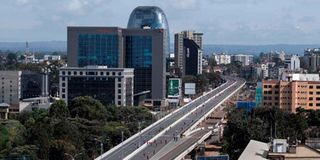Chasing complex growth rate strategy to prosperity

An aerial view of runners taking part in the Nairobi marathon as they run along the new expressway on May 8, 2022.
If we look around the world, we will find that some economies are growing at a rapid rate while others are lagging. Among the slowest-growing economies in the past decade are Yemen, Croatia, Brazil, Serbia, Libya, Venezuela, and Ukraine. Most of these regions are characterised by high unemployment, political instability, insecurity, corruption, or misallocation of limited resources.
The Covid-19 pandemic put the global economy on a somewhat level playing field with unemployment, recession, and inflation making headlines. Why are countries facing different rates of growth? If we take the case of China, India, and Kenya, it can be noted that China has been experiencing a growth rate of 10 to 11 per cent in the recent past.
The growth rate for the Indian economy has remained between five per cent to seven per cent. As per trading economics, GDP Annual Growth Rate in Kenya averaged 4.83 per cent from 2004 until 2022. The question arises, what is the cause of the difference between the growth rates of nations?
There are many determinants of growth and one of the important factors is infrastructure. Infrastructure means facilities such as electricity, telecommunication, access to water, railroad network, transportation and reliable access to energy among others.
These are the facilities that make productive activities more efficient and cost-effective. The Chinese economy spends about nine per cent of its GDP on infrastructure development whereas the latest data indicate Kenya’s investment in infrastructure at 6.5 per cent of GDP.
Promotes investment
Availability of infrastructure promotes investment in the economy. Yet some countries are still diverging. According to World Economic Forum data, while the Netherlands was 15 times richer than Kenya in 1980, by 2012 it was 24.4 times richer and the trajectory continued.
From a business perspective, for anyone who invests in any industry, the basic objective is to earn profits. In countries where infrastructural facilities are not available, the rate of investment is slow. The purpose of the investor is to sell the commodity they are producing.
Unless there are facilities such as transport, and availability of low-cost energy including electricity, this cannot be done. With the availability of infrastructure, the goods which are produced are cost-effective in the sense that the cost of manufacturing is probably lower compared to countries with infrastructure gaps.
Consequently, cost-effectively produced goods can be sold in the market at a lower price. Facilities like transportation and telecommunication lead to market integration. If markets are integrated it becomes easier for producers to sell their products in different regions locally and internationally. The availability of infrastructure makes it possible to produce goods on a large scale.
China and India for instance are producing goods at such a large scale, the cost of production is low. The nations also focus on utilising the full value chain. They are able to compete on the global front because the prices of their goods are lower in prices than competitors In Kenya if the focus on value addition is enhanced, and the value chain is strengthened involving the full stages from initial reception of raw materials to production and delivery of end products to market, employment opportunities would increase and the economy would not use as much foreign currency as it otherwise would.
The right conditions and good infrastructure in developing nations can contribute to attaining the benefits of global value chains to upgrade the economic structure.
Trade is essential to end global poverty. Countries open to international trade tend to grow faster, are more innovative, have higher productivity and provide income-generating opportunities. Integrating with the world economy through trade and global value chains helps drive economic growth. Infrastructure not only helps the country grow rapidly but also makes it competitive in the world market. An economy can remain in the world market only if it is producing goods at a lower cost.
Poor infrastructure is a key barrier to economic growth and an important constraint for human development. We can imagine how the productivity of most of the industrial world would drop if electricity service fails in one way or the other. How the lack of access to drinking water or the use of wood for cooking might have an impact on health and spread a myriad of serious diseases.
Currently, European nations are undergoing a crisis due to the high-priced energy and shortages that impact households and industries. In other nations, one can also imagine how the entire community can be disconnected from marketing services just by the absence of proper roads.
Sanitation
In developing countries basic infrastructure including power, water, sanitation, access to information and communication technologies, roads connecting all cities are insufficient. Some statistics indicate that in the emerging and developing world about 2.6 billion people lack access to electricity full-time and 1.2 billion have no electricity at all.
To put things in perspective, according to a World Bank Group survey In 2020, “the 48 sub-Saharan African countries with roughly 1.17 billion people generates the same power that Spain does with 47 million people. This level of generation and electricity represents 10 percent of what is found in all the developing countries”.
Should infrastructure development be supply-led or demand-led? This depends upon availability of funds. In the case of China, we find that the development has been supply-led. This is the reason for large amounts of foreign direct investment in China. The infrastructure facilities are already available and the foreign investors have found that they can pursue their activities in an efficient and cost-effective manner.
In Kenya and neighbouring nations, infrastructure is being developed out of necessity. Another question relating to infrastructure development is the choice of technology.
The life of infrastructure is long, so while deciding about the development of infrastructure it is important to vet which technology is to be used. The government must see to it that the technology is such that it is cost-effective and relevant.
Allocation of limited resources to address the needs of the population, without amassing any further debt should be a priority. Projects must be undertaken after careful deliberation and with full disclosure and accountability. Kenya is on track with Vision 2030 and the Big Four agenda took centre stage during the past decade.
President William Ruto’s five-point manifesto is keen on bold economic reforms and the completion of some major infrastructure projects which are underway. What we must aim to achieve is greater employment, lowering the cost of living, and encouragement of foreign direct investment whilst enhancing manufacturing and value chains locally to go hand in hand with the infrastructure development.
Ritesh Barot is a business and financial analyst. [email protected]





